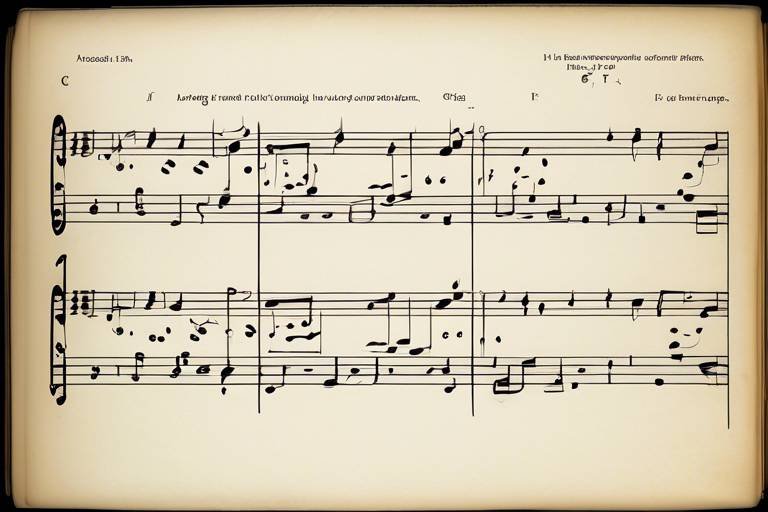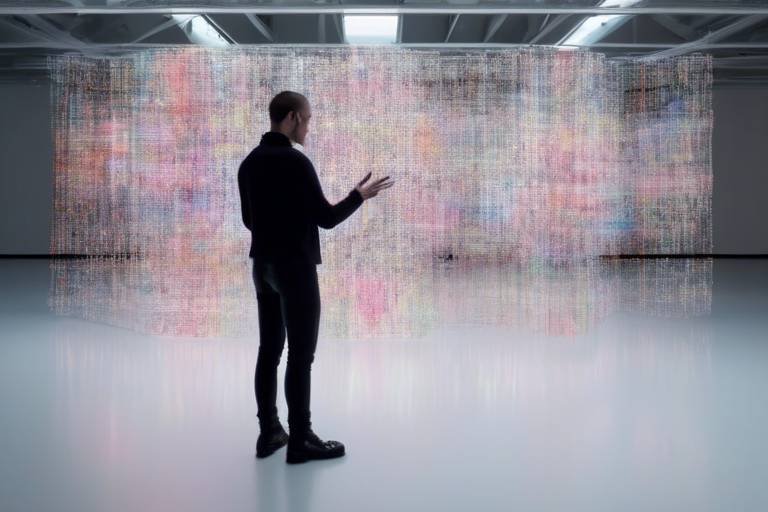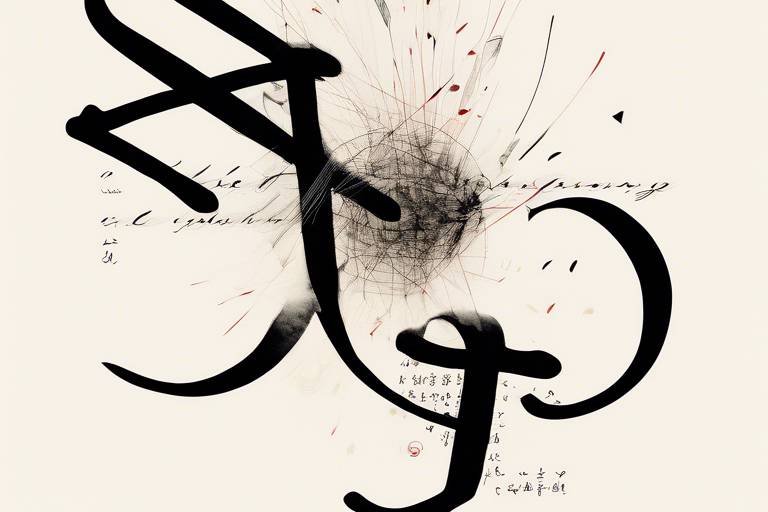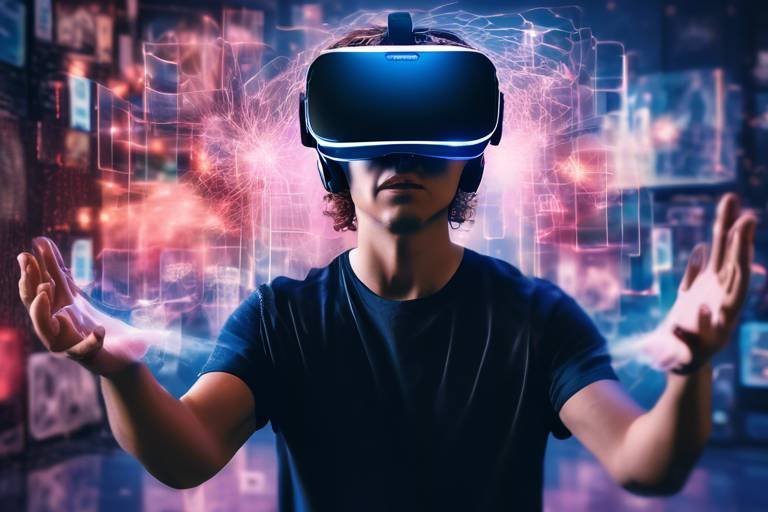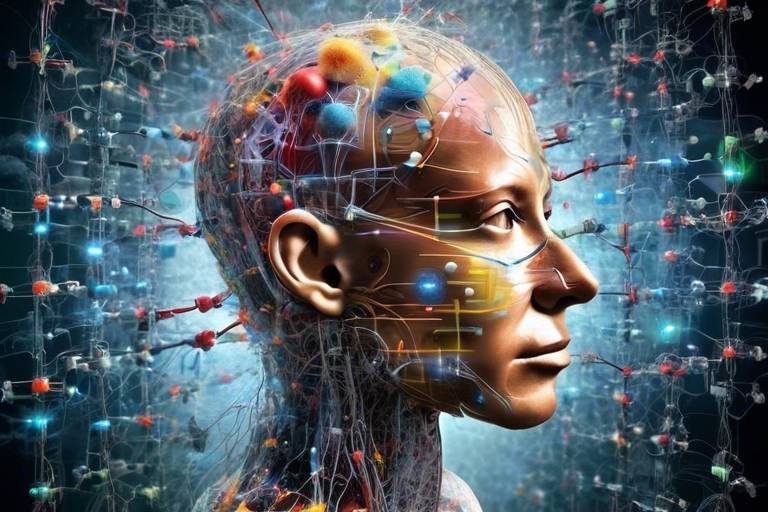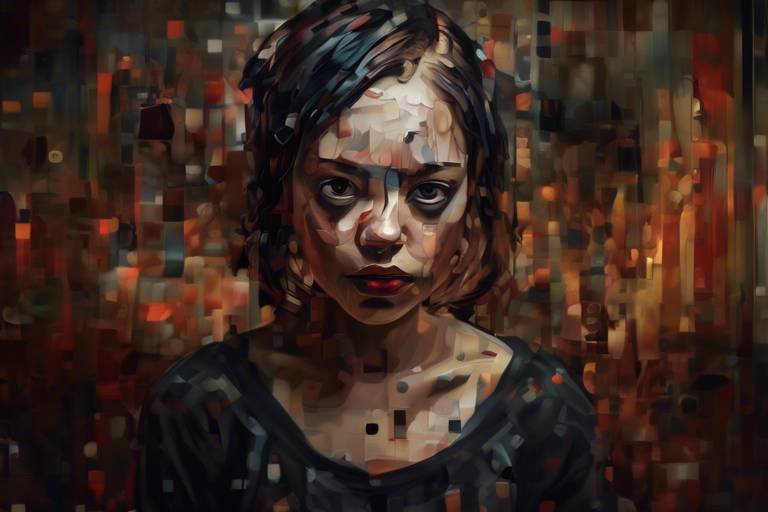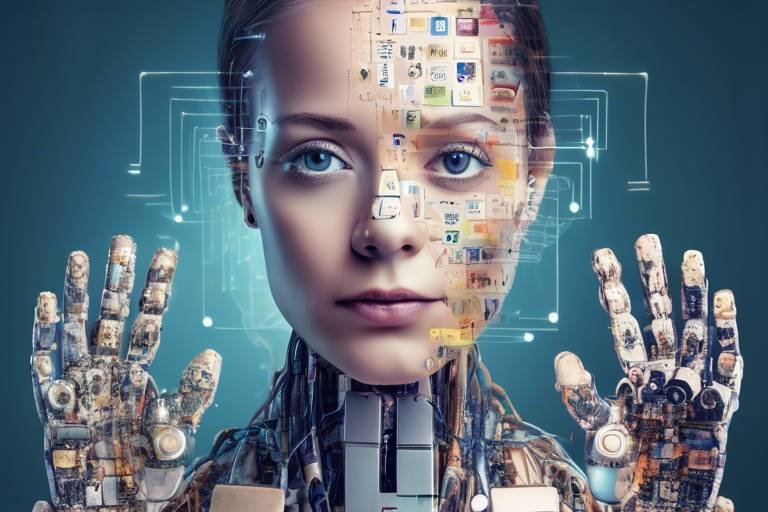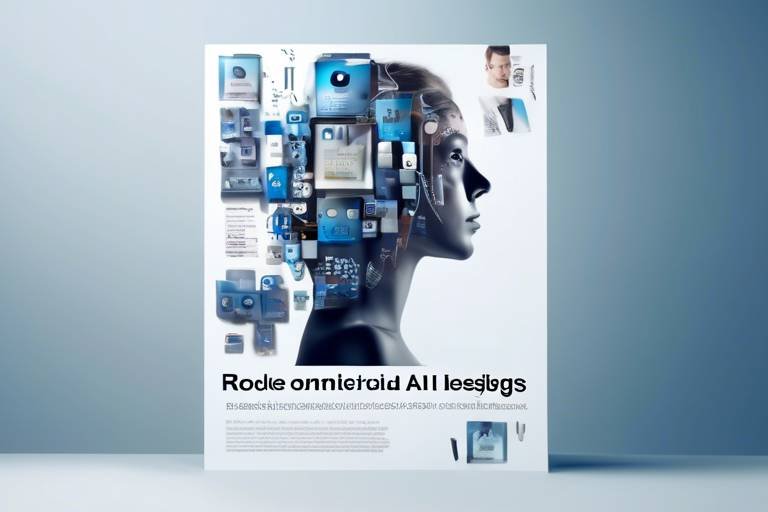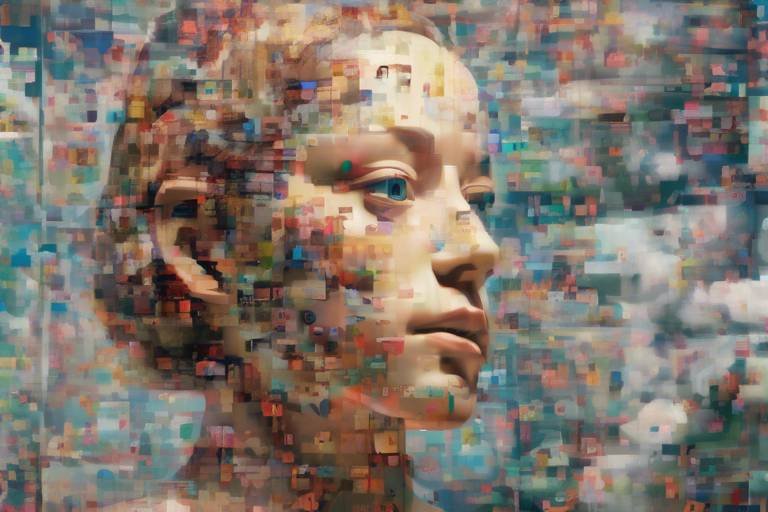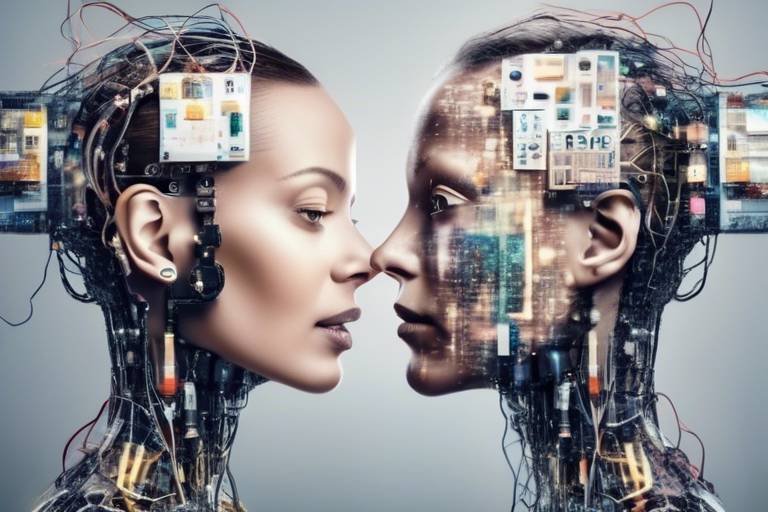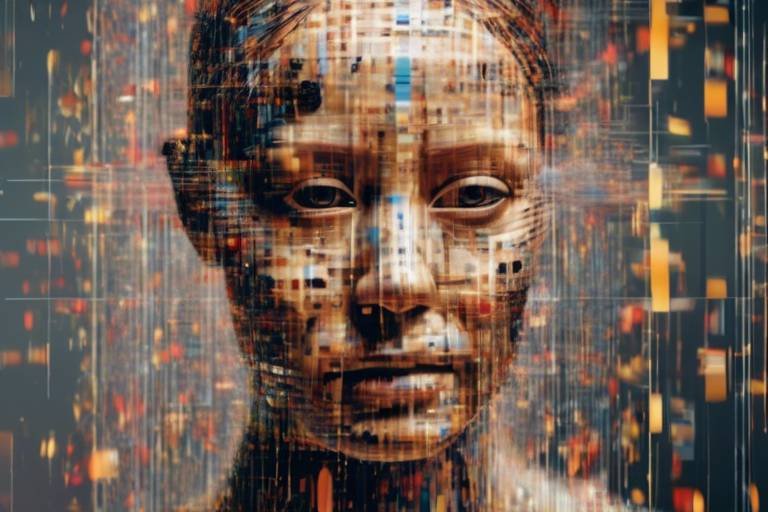The Perfect Harmonic: AI in Choral Compositions
In recent years, the world of music has seen a remarkable transformation, and at the heart of this evolution lies the integration of artificial intelligence (AI). This technology is not just a passing trend; it is reshaping the very fabric of music composition, especially in the realm of choral arrangements. Imagine a world where composers can harness the power of AI to create breathtaking harmonies and intricate vocal arrangements that were once thought to be the sole domain of human creativity. The implications of this shift are profound, opening up new avenues for composers, musicians, and the future of choral music.
As we explore the transformative role of AI in choral compositions, we will delve into its historical development, the essential elements of choral music, and the innovative tools that are available to composers today. This journey will not only highlight the capabilities of AI but also invite us to consider how it can enhance the artistic process, making it more accessible and dynamic.
The journey of AI in music composition is a fascinating one, marked by significant milestones that have paved the way for today's innovations. From the early experiments with algorithmic composition in the 1950s to the sophisticated neural networks we see today, AI has come a long way. One of the critical moments in this evolution was the development of machine learning techniques that allow computers to analyze vast amounts of musical data and learn from it.
In the context of choral music, AI has begun to play a pivotal role in creating compositions that resonate with audiences on multiple levels. It is not just about generating notes; it's about understanding the nuances of harmony, rhythm, and emotion that define great choral works. As we look back at the history of AI in music, we can see how each advancement has contributed to a richer and more complex musical landscape.
Choral composition is an intricate art form that involves a deep understanding of various musical elements. At its core, it encompasses structure, harmony, and vocal arrangement. These elements are essential for creating pieces that not only sound beautiful but also evoke emotion and connect with the audience. With AI's assistance, composers can explore these components in new ways, finding inspiration and generating ideas that may not have been possible through traditional methods.
When we break down choral music, we find several key aspects that define its character:
- Melody: The main theme of the piece, often carried by the soprano voices, which must be memorable and singable.
- Rhythm: The pulse that drives the music forward, providing structure and energy.
- Dynamics: The variations in volume and intensity that add depth and emotion to the performance.
AI tools are designed to assist composers in crafting these intricate elements, allowing for a richer and more harmonious choral experience. By leveraging AI, composers can experiment with different melodies, harmonies, and rhythms, leading to innovative compositions that push the boundaries of traditional choral music.
The interplay between melody and harmony is crucial in choral works. A well-crafted melody can be beautifully complemented by complex harmonies, creating a tapestry of sound that captivates listeners. AI can analyze existing choral pieces to understand how different harmonies interact with melodies, enabling composers to generate new and exciting combinations. Imagine a composer being able to input a simple melody and receiving a range of harmonious options that enhance the original theme—this is the power of AI in action!
Vocal arrangements are another vital aspect of choral composition. The distribution of voices—soprano, alto, tenor, and bass—must be carefully considered to achieve balance and blend within the choir. AI can optimize these arrangements by analyzing the strengths and weaknesses of individual voices, ensuring that each part contributes to the overall sound. This level of precision allows for a more cohesive performance, where every singer's voice shines while still supporting the collective harmony.
Today, composers have access to a variety of AI tools that can revolutionize their creative process. From software that generates melodies and harmonies to platforms that offer full arrangements, these tools are designed to streamline composition and expand artistic possibilities. Some popular AI tools include:
- AIVA: An AI composer that creates original scores based on user preferences.
- Amper Music: A platform that allows users to compose and produce music using AI.
- OpenAI's MuseNet: A deep learning model that can generate compositions in various styles, including choral music.
These tools not only save time but also inspire composers to explore new ideas and directions in their work, ultimately leading to more innovative choral compositions.
To illustrate the potential of AI in choral music, let's examine some real-world examples where AI has played a crucial role in composition. These case studies showcase the versatility of AI and its ability to collaborate with human creativity.
One notable project involved a collaboration between a renowned human composer and an AI system. Together, they created a choral piece that combined traditional elements with contemporary sounds, resulting in a work that challenged conventional boundaries. The partnership demonstrated how AI could enhance the creative process, allowing composers to push their artistic limits while benefiting from the analytical capabilities of machines.
The outcomes of AI-driven choral compositions are nothing short of revolutionary. These works invite new interpretations and challenge traditional notions of what choral music can be. As composers continue to experiment with AI, we can expect to see an influx of innovative pieces that redefine the genre and engage audiences in fresh and exciting ways.
As we look to the future, the trajectory of AI in choral music appears promising. Advancements in technology will likely lead to even more sophisticated tools that can assist composers in their creative endeavors. The ongoing relationship between technology and human creativity will continue to evolve, allowing for a harmonious blend of artistic expression and technological innovation. As AI becomes an integral part of the compositional process, we can only imagine the breathtaking choral works that lie ahead.
Q: How does AI enhance the creative process in choral composition?
A: AI provides composers with tools that can analyze existing music, generate new ideas, and optimize vocal arrangements, allowing for a more efficient and innovative creative process.
Q: Can AI replace human composers?
A: While AI can assist in generating music, it cannot replicate the emotional depth and personal touch that human composers bring to their work. The best results often come from collaboration between humans and AI.
Q: What are some popular AI tools for music composition?
A: Some popular AI tools include AIVA, Amper Music, and OpenAI's MuseNet, all of which offer unique features for composers looking to integrate AI into their work.

The Evolution of AI in Music
The journey of artificial intelligence (AI) in music is nothing short of fascinating, akin to watching a caterpillar transform into a butterfly. Over the decades, we have witnessed a remarkable evolution in how technology intertwines with creativity, especially in the realm of music composition. It all began in the 1950s when researchers started experimenting with algorithms to generate musical notes. This was a nascent phase, where the idea of machines composing music was still a dream, but the seeds of innovation were sown.
Fast forward to the 1980s, and we see a significant leap with the introduction of computer-generated music. The development of MIDI (Musical Instrument Digital Interface) allowed composers to connect their instruments to computers, opening up new avenues for creativity. Suddenly, the ability to manipulate sound digitally became accessible to a broader audience, paving the way for future AI advancements. It was during this period that early AI systems began to emerge, capable of analyzing musical patterns and even composing simple melodies.
As we entered the 21st century, the rise of machine learning and deep learning techniques propelled AI's capabilities to unprecedented heights. Algorithms became sophisticated enough to analyze vast amounts of musical data, learning from the styles and techniques of renowned composers. This led to the creation of AI systems that could not only generate music but also imitate specific genres or composers, effectively becoming digital muses for human creators. For instance, AI programs like OpenAI's MuseNet and Google's Magenta have showcased the ability to compose intricate pieces that resonate with human emotions.
Today, AI is not just a tool for generating music; it has become a collaborative partner for composers. Many musicians now utilize AI to enhance their creative processes, whether it's through generating unique melodies, harmonizing vocal lines, or even suggesting rhythmic patterns. The integration of AI in music composition has sparked discussions about the future of creativity itself. Will AI replace human composers, or will it merely act as a catalyst for new forms of expression? The answer lies in the fascinating interplay between technology and human artistry.
To illustrate the evolution of AI in music, consider the following table that outlines key milestones in this journey:
| Year | Milestone |
|---|---|
| 1950s | Early experiments with algorithms for music generation. |
| 1980s | Introduction of MIDI, connecting instruments to computers. |
| 2000s | Advancements in machine learning enable sophisticated music composition. |
| 2010s | AI systems like MuseNet and Magenta emerge, capable of complex compositions. |
| 2020s | AI becomes a collaborative partner for composers, enhancing creativity. |
As we look towards the future, it's clear that the evolution of AI in music is just beginning. The potential for innovation is limitless, and the relationship between human musicians and AI will continue to redefine what it means to create music. This ongoing evolution invites us to ponder the possibilities of a harmonious existence where technology and creativity coexist, each enhancing the other in ways we are only beginning to understand.
- What is AI music composition? AI music composition refers to the use of artificial intelligence technologies to create music, often by analyzing existing compositions and generating new pieces based on learned patterns.
- Can AI replace human composers? While AI can generate music, it is unlikely to fully replace human composers. Instead, it serves as a tool that can enhance creativity and provide new ideas.
- What are some popular AI music tools? Some popular AI music tools include OpenAI's MuseNet, Google's Magenta, and AIVA, which help composers create music across various genres.

Understanding Choral Composition
Choral composition is a fascinating blend of artistry and structure, where the magic of music unfolds through the collaboration of voices. At its core, choral music is not just about singing in harmony; it's about weaving together layers of sound that evoke emotions, tell stories, and create a sense of community. To truly appreciate the role of artificial intelligence in this realm, we need to break down the essential elements that define choral composition. Understanding these components can illuminate how AI can enhance and innovate the process.
First and foremost, the **structure** of a choral piece plays a pivotal role. Composers often rely on established forms, such as the **strophic**, **through-composed**, or **binary forms**, which provide a framework for the music. Each of these forms serves a unique purpose, guiding the listener through the emotional landscape of the piece. For instance, a strophic form may repeat a melody with different lyrics, creating a familiar yet evolving experience for the audience. Meanwhile, through-composed works offer a continuous flow of music that can surprise and engage listeners with its unpredictability.
Next, we have **harmony**, which is the heart of choral music. It’s all about how different vocal parts interact with each other. In a typical choral arrangement, you might find **soprano**, **alto**, **tenor**, and **bass** voices, each contributing to the overall sound. The interplay between these voices creates a rich tapestry of sound, and this is where AI can really shine. By analyzing existing compositions, AI tools can suggest harmonies that complement vocal lines, allowing composers to explore new harmonic territories that they might not have considered otherwise.
Another crucial aspect of choral composition is **vocal arrangement**. This involves the strategic distribution of voices to achieve balance and blend within the choir. A well-crafted vocal arrangement ensures that no single voice overpowers the others, creating a unified sound. AI can assist in this process by analyzing the strengths and weaknesses of individual singers, suggesting optimal voice distributions to enhance the overall performance. Imagine a scenario where AI evaluates the vocal timbre and range of each choir member, recommending arrangements that highlight their unique qualities while maintaining harmony.
Moreover, we can't overlook the significance of **melody** and **rhythm** in choral compositions. The melody serves as the memorable line that carries the piece, while rhythm provides the pulse that drives it forward. AI tools can generate intricate melodies that are not only catchy but also fit seamlessly into the harmonic structure of the piece. Additionally, rhythm can be manipulated to create tension and release, guiding the emotional journey of the listener. By leveraging AI, composers can experiment with various rhythmic patterns and melodic ideas, pushing the boundaries of traditional choral music.
In summary, understanding choral composition requires a deep appreciation for its structure, harmony, vocal arrangements, melody, and rhythm. Each of these elements plays a vital role in crafting a compelling choral piece, and the integration of AI into this process opens up exciting new possibilities. As we continue to explore the intersection of technology and creativity, the future of choral music looks brighter than ever.
- How does AI enhance choral composition? AI can analyze existing works and suggest harmonies, melodies, and vocal arrangements, allowing composers to explore new creative avenues.
- What are the key elements of choral music? The key elements include structure, harmony, vocal arrangement, melody, and rhythm.
- Can AI replace human composers? While AI can assist in the creative process, it is unlikely to replace the human touch that brings emotional depth to music.
- What tools are available for composers? There are various AI tools that can generate melodies, harmonies, and even full arrangements, streamlining the composition process.

Key Elements of Choral Music
Choral music is a rich tapestry woven from various musical threads, and understanding its key elements is essential for anyone looking to appreciate or create this art form. At its core, choral music encompasses melody, harmony, rhythm, and dynamics. Each of these components plays a vital role in how a composition feels and resonates with its audience. Imagine a beautifully crafted quilt; each patch represents a different element of music, and together they create a stunning visual and emotional experience.
When we talk about melody, we refer to the main theme of the piece—the part that often sticks in your head long after the performance. It's the tune that singers carry, and its development can evoke a range of emotions. The harmony, on the other hand, acts like the supportive cast in a play, enriching the melody and providing depth. In choral compositions, harmony is crucial as it allows different voices to interweave, creating a fuller sound. This interplay between melody and harmony is where the magic happens, and it's where AI can step in to assist composers in generating complex harmonies that might otherwise take hours to perfect.
Next, let's consider vocal arrangements. This is where the magic of choral music truly shines. A well-crafted arrangement ensures that each voice type—soprano, alto, tenor, and bass—has its moment to shine while also blending seamlessly with the others. The balance and blend of these voices create a rich soundscape that can be both powerful and delicate. AI tools can analyze existing compositions and suggest voice distributions that enhance the overall blend, making the choir sound more cohesive.
Moreover, rhythm plays a critical role in choral music. It's the heartbeat of the composition, dictating the pace and flow of the performance. Whether it's a lively, upbeat piece or a slow, reflective ballad, the rhythm sets the mood and guides the singers. Dynamics, or the variations in loudness and softness, add another layer of expressiveness. A skilled composer knows how to manipulate these elements to evoke specific feelings, and AI can help by providing suggestions based on patterns it has learned from a vast array of musical works.
In summary, the key elements of choral music—melody, harmony, vocal arrangements, rhythm, and dynamics—are interdependent and work together to create a captivating auditory experience. By leveraging AI technologies, composers can explore new possibilities in crafting these elements, pushing the boundaries of traditional choral music and inviting fresh interpretations. It's an exciting time to be involved in choral composition, where human creativity meets the innovative potential of artificial intelligence.
- What are the main components of choral music? The main components include melody, harmony, rhythm, vocal arrangements, and dynamics.
- How can AI assist in choral composition? AI can generate complex harmonies, suggest optimal vocal arrangements, and analyze existing compositions for inspiration.
- What role does rhythm play in choral music? Rhythm dictates the pace and flow of the piece, influencing the overall mood and energy of the performance.
- Can AI replace human composers? While AI can assist and enhance the creative process, it cannot fully replace the emotional depth and intuition of human composers.

Melody and Harmony
When we dive into the world of choral music, the concepts of melody and harmony are like the two sides of a coin—they are inseparable yet distinct, each playing a crucial role in creating a rich auditory experience. Imagine a beautiful tapestry where each thread represents a different vocal line; together, they create a stunning picture that can evoke a myriad of emotions. In choral compositions, the melody serves as the leading voice, guiding the listener through the emotional landscape of the piece, while harmony provides the depth and richness, filling out the sound and creating a fuller experience.
With the advent of artificial intelligence, composers now have access to tools that can assist in generating complex harmonies that complement the melody perfectly. Think of AI as a digital collaborator that can analyze existing compositions and suggest harmonic progressions that might not have been immediately apparent to a human composer. This capability opens up a world of possibilities, allowing for innovative combinations that challenge traditional norms.
For instance, AI can analyze thousands of choral pieces to identify common patterns and structures in melody and harmony. By doing so, it can generate new harmonic ideas that are both unique and fitting for the style of the composition at hand. This is particularly useful when working with large choral works, where maintaining balance and coherence across multiple vocal parts is essential.
Additionally, the integration of AI in melody and harmony creation allows composers to explore a variety of styles and genres. Whether it's a classical piece that requires strict adherence to traditional harmonic rules or a contemporary work that embraces dissonance and innovation, AI can adapt its suggestions accordingly. This adaptability is crucial in today’s diverse musical landscape, where blending genres and experimenting with sounds is increasingly encouraged.
Furthermore, AI can assist in real-time adjustments during rehearsals. Imagine a conductor who can instantly modify harmonies based on the choir's performance, enhancing the overall sound without the need for extensive rewrites. This dynamic interaction not only saves time but also fosters a more collaborative environment between human musicians and technology.
In summary, the interplay between melody and harmony in choral music is a fascinating realm that AI is beginning to revolutionize. By leveraging AI tools, composers can unlock new creative avenues, ensuring that the future of choral music remains vibrant and exciting. The potential for AI to generate intricate harmonies that enhance melodies is not just a technological advancement; it’s a leap towards a more collaborative and innovative musical future.

Vocal Arrangements
When it comes to choral compositions, play a pivotal role in shaping the overall sound and emotional impact of a piece. Imagine a beautifully orchestrated garden, where each flower represents a different voice, harmonizing to create a stunning visual symphony. In choral music, each voice part—soprano, alto, tenor, and bass—must work in harmony to achieve a balanced and cohesive sound. This is where the magic of AI can truly shine, offering composers innovative tools to optimize voice distribution and enhance the blend within the choir.
One of the key aspects of effective vocal arrangements is ensuring that each voice part complements the others. This involves understanding the range and timbre of each vocal section. For instance, sopranos often carry the melody, while altos provide a rich harmonic foundation. Tenors and basses add depth and resonance, creating a fuller sound. AI can analyze these vocal characteristics, suggesting arrangements that not only maintain balance but also highlight the unique qualities of each voice type.
Moreover, AI tools can assist composers in determining the optimal distribution of vocal lines across different sections. By analyzing existing choral works, AI can identify successful patterns and suggest new combinations that might not have been considered otherwise. This can lead to exciting and unexpected vocal arrangements that challenge traditional norms. For example, imagine a piece where the basses take the lead on the melody, creating a fresh perspective that captivates the audience. Such innovative arrangements can be generated with the help of AI, pushing the boundaries of what is possible in choral music.
Additionally, the use of AI in vocal arrangements can streamline the creative process. Composers can input their ideas into AI software, which can then generate multiple variations of a given arrangement. This allows composers to experiment with different configurations quickly, saving time and enhancing creativity. The result is a more dynamic and engaging choral piece that resonates with both performers and listeners alike.
In conclusion, vocal arrangements are the backbone of choral music, and the integration of AI technology offers exciting possibilities for composers. By leveraging AI tools, musicians can explore new sounds, optimize voice distribution, and create arrangements that challenge the status quo. As we continue to embrace these technologies, the future of choral compositions looks brighter than ever, inviting both composers and audiences to experience the beauty of harmonized voices in novel ways.
- How does AI enhance vocal arrangements in choral music?
AI analyzes vocal ranges and timbres, suggesting optimal distributions and innovative combinations that enhance the overall sound. - Can AI create complete choral compositions?
Yes, AI tools can generate melodies, harmonies, and arrangements, allowing composers to explore new creative possibilities. - What are the benefits of using AI in choral composition?
AI streamlines the creative process, saves time, and encourages experimentation, resulting in unique and engaging musical pieces.

AI Tools for Composers
In the ever-evolving landscape of music composition, artificial intelligence has emerged as a powerful ally for composers, particularly in the realm of choral music. These AI tools are not just gimmicks; they are transforming the way artists create and innovate. Imagine having a virtual assistant that not only understands your musical preferences but can also generate melodies and harmonies that resonate with your vision. This is the reality that many composers are beginning to experience.
One of the most exciting aspects of AI in music is its ability to analyze vast amounts of data. By studying existing choral compositions, AI can identify patterns, styles, and structures that define successful pieces. This analysis allows composers to draw inspiration from a rich tapestry of musical history while pushing the boundaries of creativity. For instance, tools like OpenAI's MuseNet and AIVA can generate original compositions by learning from thousands of existing works, providing composers with a springboard for their ideas.
Moreover, these AI tools can assist in various stages of the composition process. From generating initial motifs to suggesting harmonies and even creating full arrangements, AI can streamline workflows and reduce the time spent on repetitive tasks. This means composers can focus more on the artistic aspects of their work rather than getting bogged down in technical details. For example, software like Amper Music allows users to input specific parameters and receive an entire choral arrangement tailored to their specifications. It's like having a co-composer who never tires!
However, the integration of AI in choral composition isn't just about convenience; it also opens up new avenues for exploration. Composers can experiment with unconventional scales, rhythms, and harmonies that they might not have considered before. This is where the magic happens—when human creativity meets the analytical power of AI, the results can be astonishing. For instance, AI-generated compositions can introduce unexpected elements that challenge traditional norms, inviting fresh interpretations and emotional responses from the audience.
To better understand the impact of AI tools on choral composition, let's take a look at a few notable examples:
| AI Tool | Functionality | Notable Features |
|---|---|---|
| AIVA | Composition Generation | Creates full orchestral pieces, including choral arrangements. |
| Amper Music | Music Creation | Allows customization based on mood, genre, and instrumentation. |
| OpenAI's MuseNet | Melody and Harmony Generation | Can generate music in various styles, from classical to pop. |
As we look to the future, it's essential to recognize that these tools are not here to replace human composers; rather, they are here to enhance the creative process. The collaboration between human intuition and AI's analytical capabilities can lead to groundbreaking compositions that resonate with audiences in new and profound ways. So, whether you're a seasoned composer or just starting your journey, embracing these AI tools could be the key to unlocking your full musical potential.
In conclusion, AI tools for composers are revolutionizing the world of choral music. They provide a unique blend of inspiration, efficiency, and innovation that can elevate compositions to new heights. As technology continues to advance, the possibilities for creativity in choral arrangements will only expand, inviting composers to explore uncharted territories in their musical journeys.
- What is the role of AI in music composition? AI assists composers in generating melodies, harmonies, and arrangements, enhancing the creative process.
- Can AI replace human composers? No, AI is a tool that complements human creativity, allowing for new forms of expression.
- What are some popular AI tools for composers? Some notable tools include AIVA, Amper Music, and OpenAI's MuseNet.
- How can AI improve choral compositions? AI can analyze existing works, suggest innovative harmonies, and streamline the composition process.

Case Studies of AI Compositions
The intersection of artificial intelligence and choral music has birthed some truly fascinating compositions that challenge our understanding of creativity. One standout example is the project known as "AIVA" (Artificial Intelligence Virtual Artist), which has been making waves in the music industry. AIVA is designed to compose emotional soundtracks, and its capabilities extend into the realm of choral music. By analyzing vast databases of existing compositions, AIVA can generate pieces that resonate with the emotional depth often sought in choral arrangements. Imagine a choir singing a piece that was birthed from an algorithm, yet still feels profoundly human!
Another notable case study is the collaboration between human composers and AI in the "Choral AI" project. This initiative brings together seasoned choral composers and AI technologies to create new works that blend traditional techniques with modern innovations. For instance, one piece generated through this collaboration utilized machine learning algorithms to analyze the dynamics and phrasing of classic choral works. The result? A stunning composition that not only respected the choral tradition but also pushed its boundaries, inviting performers and audiences alike to experience something entirely new.
Moreover, the "OpenAI Jukebox" project has shown remarkable potential in generating musical compositions across various genres, including choral music. This AI model can create music with lyrics, harmonies, and even stylistic nuances that mimic famous composers. Imagine a choir performing a piece that sounds as though it could have been written by a contemporary master, but was actually generated by an AI! Such compositions spark discussions about authorship and creativity in the digital age.
To further illustrate the impact of AI in choral compositions, we can look at a few specific outcomes from these case studies:
| Project | AI Tool | Outcome |
|---|---|---|
| AIVA | AI Composition Engine | Emotionally resonant choral pieces |
| Choral AI | Machine Learning Algorithms | Innovative choral works blending tradition and technology |
| OpenAI Jukebox | Neural Network Model | Choral compositions mimicking renowned composers |
These examples not only showcase the capabilities of AI in generating choral compositions but also emphasize the collaborative spirit that can arise when humans and machines work together. The synergy between traditional choral techniques and cutting-edge technology is paving the way for a new era in music composition, where the possibilities are as limitless as the imagination itself. As we continue to explore these innovative outcomes, it becomes clear that AI is not just a tool; it is a partner in the creative process, inviting us to reimagine the future of choral music.
- Can AI really compose music that feels emotional? Yes, AI can analyze emotional elements in existing compositions and replicate them, creating music that resonates with listeners.
- How does AI collaborate with human composers? AI tools can assist in generating melodies and harmonies, which human composers can then refine and adapt to create a cohesive piece.
- What are some ethical considerations regarding AI in music? Questions about authorship, creativity, and the potential for AI to replace human musicians are important discussions in the industry.

Collaborative Projects
In the ever-evolving landscape of music, the collaboration between human composers and artificial intelligence is nothing short of revolutionary. Imagine a scenario where a seasoned composer, brimming with creativity, teams up with an AI that can analyze vast amounts of musical data in seconds. This partnership not only enhances the creative process but also opens up a treasure trove of possibilities for choral music. In these collaborative projects, the human touch and the analytical power of AI combine to produce compositions that are rich, intricate, and often surprising.
One fascinating example of such collaboration is the project between the renowned composer David Cope and his AI software, Experiments in Musical Intelligence (EMI). Cope’s work demonstrates how AI can be used to generate new compositions that mimic the styles of famous composers. By feeding the AI a plethora of choral works, Cope was able to create pieces that not only respected traditional structures but also introduced innovative elements that challenged the norms of choral music. The results were astonishing, showcasing how AI can serve as a creative partner rather than just a tool.
Moreover, collaborative projects often involve workshops where composers and AI developers come together to explore the boundaries of what is possible. These workshops can lead to the creation of unique choral pieces that reflect a blend of human emotion and AI precision. For instance, during a recent workshop in Berlin, composers utilized AI algorithms to analyze the emotional impact of various harmonies and melodies. The insights gained from this analysis helped them craft pieces that resonated deeply with audiences, demonstrating the profound impact of AI on the creative process.
In addition, universities and research institutions are increasingly embracing these collaborative efforts. They are forming interdisciplinary teams that include musicians, computer scientists, and AI specialists. This collective expertise allows for the development of advanced AI tools specifically designed for choral composition. For example, a project at MIT focused on creating an AI that could suggest harmonic progressions based on the emotional tone of the lyrics. This innovation not only aids composers in their creative endeavors but also enriches the overall quality of choral music produced.
As we look to the future, the potential for collaborative projects between human composers and AI seems limitless. These partnerships not only push the envelope of what is musically possible but also encourage an ongoing dialogue about the role of technology in the arts. By embracing AI as a collaborative partner, composers can explore new realms of creativity, resulting in choral works that are both innovative and deeply expressive.
- What is the role of AI in choral music composition?
AI can assist composers by generating melodies, harmonies, and even full arrangements, enhancing the creative process. - Are AI-generated compositions considered real music?
Yes, AI-generated compositions can be seen as real music, especially when they incorporate human creativity and emotion. - Can AI replace human composers?
While AI can generate music, it is unlikely to replace human composers, as the emotional and personal touch of human creativity remains irreplaceable. - How can I get started with AI in music composition?
There are various AI tools and software available for composers, many of which offer user-friendly interfaces to help beginners explore AI-assisted composition.

Innovative Outcomes
The fusion of artificial intelligence and choral music has led to some truly that are reshaping the landscape of musical composition. Imagine a world where composers can harness the power of AI to explore uncharted territories in harmony and vocal arrangements. This collaboration between human creativity and machine learning is not just a trend; it’s a revolution that challenges traditional notions of music creation.
One of the most exciting aspects of AI in choral music is its ability to generate compositions that might not have been conceived by human minds alone. For instance, AI can analyze vast databases of existing choral works and identify patterns that are often overlooked. By doing so, it can suggest novel chord progressions or intricate counterpoints that add depth to a composition. This capability allows composers to push the boundaries of their creativity and explore new musical landscapes.
Consider the way AI can assist in crafting unique vocal arrangements. In traditional settings, composers often rely on their intuition and experience to distribute voices within a choir. However, AI tools can analyze the strengths and weaknesses of individual singers, optimizing voice distribution for balance and blend. This not only enhances the overall sound but also ensures that each voice is utilized to its fullest potential. The result? A richer, more dynamic choral performance that captivates audiences.
Moreover, AI-generated compositions have the potential to challenge the very essence of what we consider to be choral music. For example, some AI systems can create pieces that incorporate unconventional elements, such as electronic sounds or non-traditional rhythms, blending genres in ways that were previously unimaginable. This kind of innovation invites composers to rethink their approaches and encourages performers to embrace a more diverse repertoire.
To illustrate the impact of AI, let’s take a look at a few notable examples:
| Project Name | Description | Outcome |
|---|---|---|
| AI Choral Project | A collaboration between human composers and AI to create a new choral piece. | Resulted in a unique blend of traditional choral elements with modern influences. |
| HarmonAI | An AI tool that generates harmonies based on input melodies. | Enabled composers to experiment with complex harmonizations effortlessly. |
| VocalBlend | A software that analyzes choir members' vocal ranges and suggests optimal arrangements. | Improved overall sound quality and balance in performances. |
As we continue to explore the innovative outcomes of AI in choral music, it’s clear that this technology is not merely a tool but a collaborator that inspires new ways of thinking about music. The possibilities are endless, and as composers embrace these advancements, we can expect to see a wave of creativity that redefines the future of choral arrangements.
- How does AI influence the creative process in choral music?
AI can provide suggestions for melodies, harmonies, and arrangements, helping composers break through creative blocks and explore new ideas. - Can AI replace human composers?
No, AI serves as a tool to assist and inspire human creativity rather than replace it. The emotional depth and nuance of human compositions remain irreplaceable. - What are the risks of using AI in music composition?
One concern is that reliance on AI might lead to homogenized music, lacking the unique touch of individual composers. Balancing AI assistance with personal creativity is essential. - Are there any successful examples of AI in choral music?
Yes, there are numerous projects where AI has been used to create innovative choral pieces, showcasing the potential of this collaboration.

The Future of AI in Choral Music
As we gaze into the crystal ball of choral music, the future appears bright and brimming with possibilities, thanks to the ever-evolving capabilities of artificial intelligence. Imagine a world where composers can seamlessly blend their artistic visions with the precision and creativity of AI. This partnership is not just a fleeting trend; it marks a profound shift in how music is created, performed, and experienced. The potential advancements in AI technology promise to revolutionize not only the composition process but also the very nature of choral music itself.
One of the most exciting prospects is the ability of AI to analyze vast amounts of musical data, learning from countless compositions across various genres and styles. This analytical power can lead to the generation of new choral works that are not only innovative but also deeply rooted in tradition. For example, AI can study the harmonic structures of classic choral pieces and use this knowledge to inspire new compositions that honor the past while pushing the boundaries of creativity.
Moreover, as AI tools become more sophisticated, we can expect them to offer increasingly personalized experiences for composers. Imagine an AI that understands a composer’s unique style and preferences, suggesting melodies or harmonies that resonate with their artistic voice. This collaborative synergy between human creativity and machine learning could pave the way for a new genre of choral music that reflects diverse influences and styles.
Additionally, the future of AI in choral music holds exciting implications for performance. With advancements in real-time processing, AI could assist conductors in managing vocal balance and dynamics during live performances. Picture a scenario where an AI system analyzes the sound in the moment, adjusting the balance of voices to ensure that every note is heard clearly, creating a more harmonious and engaging experience for both performers and audiences alike.
However, as we embrace these advancements, we must also consider the ethical implications of AI in music. Questions about authorship, originality, and the role of human emotion in art will inevitably arise. Will AI compositions be viewed as less valuable than those crafted solely by human hands? Or will they be celebrated as a new form of artistic expression? These are critical questions that the music community will need to address as we move forward.
In conclusion, the future of AI in choral music is not just a technological evolution; it’s a cultural revolution. As composers, musicians, and audiences navigate this new landscape, the key will be to embrace the potential of AI while honoring the rich traditions of choral music. The harmony between human creativity and artificial intelligence could unlock a new era of musical expression, inviting us all to participate in this exciting journey.
- How will AI change the role of composers in choral music? AI will serve as a collaborative tool, allowing composers to explore new ideas while maintaining their unique artistic voice.
- Can AI-generated music evoke human emotions? While AI can analyze and replicate emotional elements in music, the depth of human emotion remains a unique aspect of human-created art.
- Will AI compositions be considered legitimate music? As AI becomes more integrated into the music creation process, perceptions will evolve, and AI compositions may be embraced as a new genre.
Frequently Asked Questions
- How is AI transforming choral music composition?
AI is revolutionizing choral music by providing composers with advanced tools to create intricate melodies and harmonies. By analyzing vast amounts of musical data, AI can suggest unique arrangements and optimize vocal distributions, making the creative process more efficient and innovative.
- What are some key elements of choral music that AI can enhance?
AI can enhance various elements of choral music, including melody, harmony, and vocal arrangements. It can generate complex harmonies that complement existing melodies and help distribute vocal parts for better balance and blend within a choir.
- Can AI create complete choral compositions?
Yes, AI can generate complete choral compositions, including melodies, harmonies, and arrangements. Many composers use AI tools to streamline their creative process, allowing them to focus on the artistic aspects while the technology handles the technical details.
- What are some examples of successful AI-assisted choral compositions?
There are numerous examples of successful AI-assisted choral compositions, showcasing innovative outcomes that challenge traditional norms. Collaborative projects between human composers and AI systems have resulted in unique pieces that blend human creativity with machine learning capabilities.
- What does the future hold for AI in choral music?
The future of AI in choral music looks promising, with ongoing advancements in technology that will likely enhance the relationship between human creativity and AI. As AI tools become more sophisticated, we can expect even more innovative compositions and collaborations in the choral music landscape.
- Are there any specific AI tools recommended for composers?
Yes, there are several AI tools designed specifically for composers, such as software that generates melodies, harmonies, and full arrangements. These tools can help streamline the composition process and provide new avenues for creative exploration.
- How can AI assist in optimizing vocal arrangements?
AI can analyze the strengths and weaknesses of individual voices within a choir and suggest optimal distributions for each part. This ensures that the final composition achieves the best possible balance and blend, enhancing the overall performance quality.

